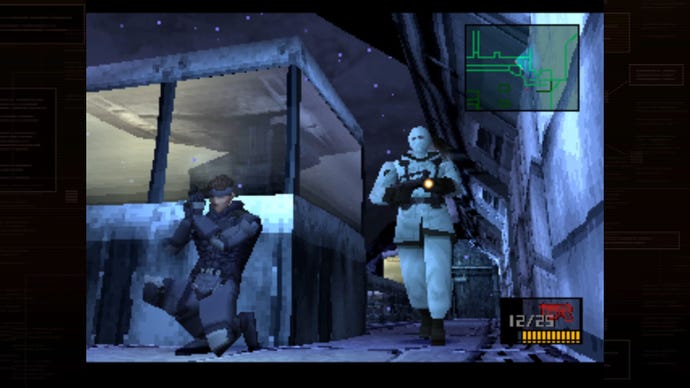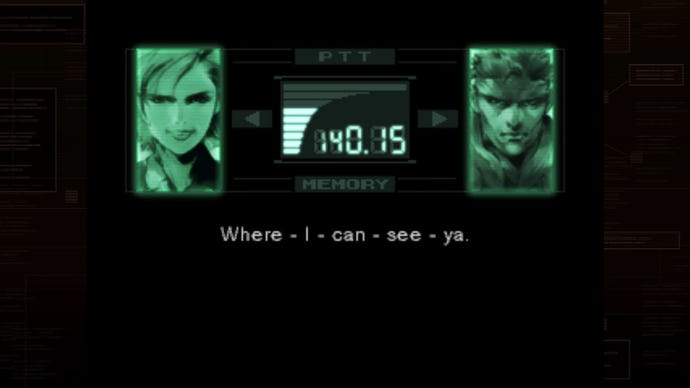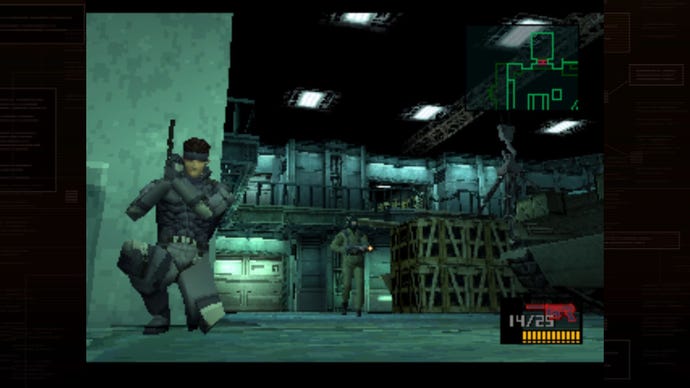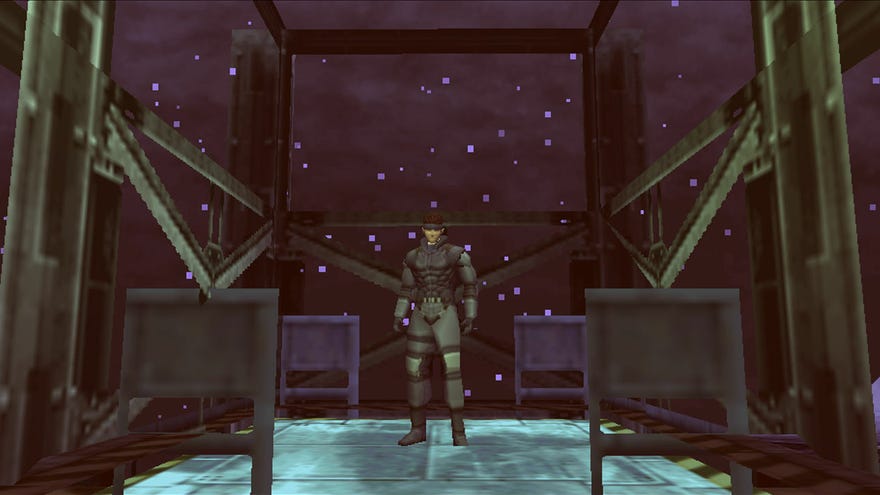Metal Gear Solid was a decent stealth game, but an all time horror game
It’s like one my Japanese animes, but spookier
In the wake of publishers adopting NFTs and predictive language programs so flimsy that even 1998 Kojima would have laughed you out of the room for daring to call them actual AI, you fools, you complete donkeys, Konami’s infamous pivot-to-pachinko seems almost quaint now. Perhaps embarrassed by the relatively small amount of egg on their face compared to some of their more ridiculous contemporaries, Konami have decided to come crawling back to try and buy our collective forgiveness by way of their second-only-to-Squeenix PS1 back catalogue. Well it won’t work, you swines! What’s that? Suikoden remasters? Well, it still won’t work! Metal Gear Solid on Steam, you say? Balls. Balls and zounds.
MGS1 has, of course, been available via GOG for quite a while now. It’s a noble, if barebones port, but it does mean I have Snake-related options besides dusting off my PS1 classic, which is currently doing a bang-up job keeping a dodgy table bang-upright. Either way, I’ve found myself on a bit of Metal Gear kick recently. Phantom Pain, for all its narrative faults, holds up still as a cracking stealth sandbox rivalled only by Hitman. And MGS1 is still dramatic, still goofy, still alternately comedically overwrought and genuinely touching. But most of all, it's still haunted by the same ghosts that dwelled inside it all those years ago.
We might best describe MSG1’s tone as “haunted Tom Clancy”. The intro sequence is all spy thriller hustle and bustle peppered with military acronyms, because while there’s plenty of time to pontificate about love and the blooming on the battlefield thereof, these men are far too serious to waste time saying, “SEAL Delivery Vehicle,” or, “On Site Procurement”. So far, so Splinter Cell. But as soon as Solid swims up to the surface and enters the tunnel, things immediately get very odd. The Gaelic opera. The rebirth imagery. The slanted camera angles. The slimy, grey-green environments.
We’ve now got some truly excellent indie art movements based on the notion that the distinctive unreality of worlds rendered in PS1 polygons are inherently spookier than photorealism, but I strongly believe MGS1 was distinctly ‘off’ for the time, too. “Ew, gross!” exclaims Meryl when Solid takes off Mantis' gas mask, somehow unfazed that literally everyone else in this world also looks like they've had their scalp stitched back on with potato tubers. As a critic, I’ve definitely used the phrase, “This remake is like how you remember it when you were a tiny idiot!”, but I don’t think that could ever be true for MSG1, because all the weird jaggies and oddities are part and parcel with the rest of my nostalgia for it. Things like Meryl’s clavicle that looks like a badly stitched up wound, or Baker’s ghoulish non-face. These weren’t blanks I filled in with my tiny 1998 mind until they looked like Cyberpunk 2077 or whatever. These were things I remember clearly, and just accepted as part of the game’s whole schtick.

Not for nothing, that tone has more in common with Silent Hill than it does Resident Evil. A creeping, atmospheric, and ultimately tragic brand of horror. Years later, MGS4 would send us to the corpse of Shadow Moses island in a deliberate “God, I’m exhausted, aren’t you exhausted?” Kojima play, but even back then, everything just felt so sad and worn out from the get go. MGS4’s Old Snake might be a more deliberate visual metaphor for his creator’s ennui, but there’s plenty here to suggest that this game’s Solid is already a ghost of himself.
It’s interesting, because I think most of us associate MGS1’s Solid as Solid in his prime - it’s this association MGS2 mostly plays off of, after all. My old mate Gary from down the very serious bloke’s pub reckons that this assumption is more meta-textual than textual, though. This is Solid’s most famous and commercially successful outing, so this is the version of him that’s become crystalised in memory. But playing through it again, in context, MGS1 is already set up as the melancholy swansong for an aging 80s video game character with very little junk left in his dummy thicc trunk.
Both the soundtrack and voice acting go a long way to prop up the creepy unreality of Shadow Moses. There are a few voice performances in this game that come across as not just fraught, but downright terrified. Take the DARPA Chief. The man sounds absolutely broken. If you know the twist, the effect is lessened somewhat, until you realise that this anxious version of the Chief is likely a reflection of his final hours being tortured by Ocelot, and observed by Decoy Octopus. It’s also here we get our first glimpse of Metal Gear Rex, treated by both narration and camera less like a piece of technology, and more like an immortal slasher villain with decades of lore - a Kreuger or a Jason.

The first fight with Ocelot, with Arms Chief Baker tied to a column surrounded by C4 and wires, is equally unsettling. This isn’t a slick spy thriller shootout followed by a tense bomb disarming. The whole thing is too medieval, too analogue. Ocelot isn’t a smooth operator, he’s a showman, a camp theatre conductor. It lends the scene the vibe of a macabre stage play, and then we get more of those tortured, unmooring monologues from Baker himself. (Coincidentally, Ocelot’s first appearance involved him having fun with Baker, and his last featured Baker sucking all the fun out of Ocelot. Kojima, you sly dog!).

This is also our first glimpse of Gray Fox, the cyborg ninja whose boss battle later is one of MGS1’s more overt, but undoubtedly more effective, horror moments. The lead up through the murder corridor is masterful, if characteristically undermined by Solid’s comments about it looking "like they were cut up by some sort of... blade!” You’re doing great sweetie. Carry on. As the fight with Gray Fox progresses, it becomes less the shounen anime that Otacon remarks on, and more the utterly chilling mental breakdown of an already broken man. Gray Fox’s voice performance here makes my blood go all funny. The head shuddering doesn’t help either.
Alongside the ninja, and the squawking clouds that accompany Vulcan Raven, the fight with Psycho Mantis is MGS1’s most overt horror scene, but it’s also the sequence that goes furthest to intentionally undermine its own gravitas with fourth wall breaks, and somehow ends up making the whole thing even freakier in the process. It isn’t scary that Mantis reads my memory card and vibrates my controller (or, did anyway). It’s actually quite cute, and that’s the scary part. Mantis being cute is somehow more threatening than his actual threats. And it’s here the slightly magical unreality of the whole thing starts to come into focus.

I find the distinction between horror and magical realism an interesting one to try and unpick. I’d normally say it’s to do with optimism and a sense of playfulness, but MGS1 has these qualities already. So let’s try this: magical realism employs dissociation to make us re-assess and re-appreciate the beauty in the mundane. Horror employs dissociation to unmoor us from a place of comfort and disarm us so we become malleable and easily frightened. That’s a messy analysis, all told, but I think it goes some way to explain why so much of MGS1 feels almost somnambulant in the way it carries itself.
To use a neater comparison, then: magical realism is dreamlike, horror is nightmarish. Both are flaps of the same cardboard box, but they point in opposite directions. Neither of these directions necessarily need to involve a rookie militia member whose defining personality trait is that he shits himself a lot, but such elements are actually strangely beneficial to both ends of the spectrum. Again, it’s that disarming thing. I’m not sure we necessarily need to pop MGS1 in the ‘horror’ category or anything, but playing through it again, I’m surprised at how much of the game works by operating on horror game principles. The isolation. The cavernous, oddly empty military complex. The sense of being incredibly out of your depth at all times. Let’s hope Kojima and Del Toro finally get that collab off the ground at some point, eh? I reckon the man’s got at least one more horror all-timer in him.


